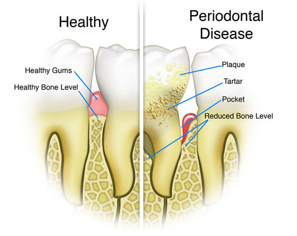What is Osseous Surgery?
When initial treatments, such as scaling and root planing, are not enough, a more direct approach may be necessary. Osseous surgery, also know as flap surgery or pocket reduction surgery, is the next step in getting your teeth into healthy shape.
When periodontal disease is present, the supporting tissue and bone around the tissue is destroyed, forming pockets around the tooth. These pockets become deeper when left untreated over time, forming an optimal haven for harmful bacteria to accumulate.
Osseous surgery aims at gaining access to the roots of the teeth to remove tartar and disease-causing bacteria.
 Goals of Osseous Surgery
Goals of Osseous Surgery
- Reducing bacteria and it’s spread
- Not only do the bacteria localized in the gums harm your mouth, but it can also spread throughout the body. This bacterial spread can potentially promote life-threatening conditions such as heart disease and respiratory disease. By removing the tartar deep under the gums this can help reduce the risk of damage caused by bacteria.
- Preventing Bone Loss
- The presence of periodontal bacteria causes the immune system to release an inflammatory response and can lead to bone loss in the jaw region. This bone loss could potentially cause teeth to fall out.
- Enhancing the Smile
- Mouths affected by periodontal disease are often unattractive. Brown gums, rotting teeth, bad breath, and ridge indentations can lower a person’s confidence even to the point they are too self-conscious to smile. Fortunately, by reducing the bacteria and disease present it is able to restore your mouth to its former radiance.
- Assisting in Oral Home Care
- As gum pockets deepen, it becomes impossible to reach that far below the gum line, making brushing and flossing difficult. You are unable to gain access to these areas resulting in inadequate cleaning. Osseous surgery reduces the size of the pockets, making it easier to floss and brush, thereby preventing further disease.
Osseous Surgery Procedure
 Oral or IV sedation is coupled with this procedure to ensure you are in the most comfortable state as we can provide. This is a conscious sedation where you are breathing all on your own and you can respond to any commands we ask (open/close your mouth, bite down, etc.).
Oral or IV sedation is coupled with this procedure to ensure you are in the most comfortable state as we can provide. This is a conscious sedation where you are breathing all on your own and you can respond to any commands we ask (open/close your mouth, bite down, etc.).
A local anesthetic is used to numb the area. Dr. Arastu will then make incisions around each tooth of the infected area along the gum line to release the gum tissue. This allows access to the roots of the teeth and areas unreachable with normal instruments. He will then thoroughly clean the flapped open region and recontour the bone around the teeth. Bone grafting may be necessary to fill in any large defects. After completion, the gums will be sutured back into place and usually covered with dressing.
What To Expect After Surgery
Following your surgery, you will likely be prescribed a medication to control any pain while the surgical site heals. Depending on the kind of stitches used, we may need to schedule an appointment to remove them six to ten days later. After about a month of healing, we will check on the progress of the surgery site and make sure everything is healing properly.
Because the surgery involves trimming and reshaping your gum tissue, this may create the illusion that your tooth is longer than before. It may also be more sensitive to temperature changes. To control this effect, we recommend sensitivity toothpaste.

